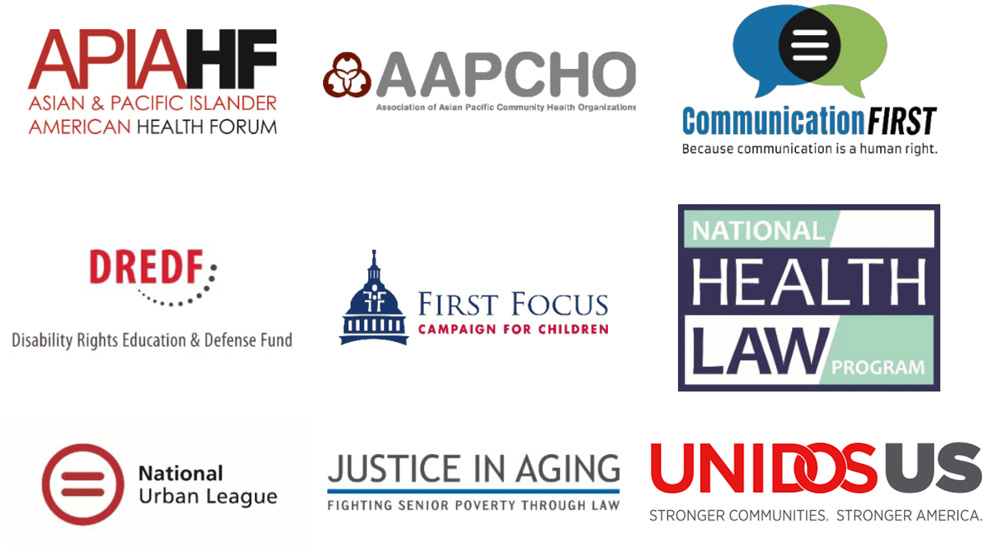
May 29, 2020
[su_row]
[su_column size=”1/2″ center=”no”]
The Honorable Mitch McConnell
Majority Leader
United States Senate
Washington, D.C. 2051
The Honorable Nancy Pelosi
Speaker
U.S. House of Representatives
Washington, D.C. 20515
[/su_column]
[su_column size=”1/2″ center=”no”]
The Honorable Charles Schumer
Minority Leader
United States Senate
Washington, D.C. 20510
The Honorable Kevin McCarthy
Minority Leader
U.S. House of Representatives
Washington, D.C. 20515
[/su_column]
[/su_row]
Dear Majority Leader McConnell, Minority Leader Schumer, Speaker Pelosi, and Minority Leader McCarthy:
We are organizations that work with and advocate for Limited English Proficient (LEP) populations, deaf and hard-of-hearing communities, blind persons, and people who cannot rely on speech to be heard and understood. We write to you in support of ensuring the federal response to the COVID-19 pandemic adequately meets the communication and language access needs of these populations that has yet to be addressed by your response legislation. Specifically, we urge you to dedicate funding and oversight to entities providing resources and working to support the health of communities across the country to ensure both written and oral communication is fully accessible.
Federal civil rights laws require entities receiving federal assistance to provide equal access to persons needing language and communication assistance, including Title VI of the Civil Rights Act of 1964, the Americans with Disabilities Act, Section 504 of the Rehabilitation Act of 1973, Section 1557 of the Affordable Care Act, and Executive Order 13166. Yet, despite these protections, we have heard, and media stories have corroborated, that these communities are facing consistent barriers to COVID-19 testing and treatment.
Reporting Demonstrates Gaps in Communication
While the entire country fears contracting COVID-19, the 25 million LEP individuals, 37.5 million people with difficulty hearing, and 5 million people who cannot rely on speech to communicate are experiencing an additional fear of being unable to learn and communicate about their medical and economic circumstances.
These barriers are harming patient quality of care. The Los Angeles Times has reported that some American Sign Language interpreters are risking their lives to be in hospitals for patients that need them.[1] In Fresno, many linguistically diverse communities are scrambling to develop their own translated materials covering health and economic information.[2] In New York, for patients that speak Spanish, French Creole and other languages, hospitals that have may have little experience with remote interpretation services are struggling to meet their needs.[3] These struggles are exacerbated for older adults and people with disabilities who are at greater risk of serious illness from COVID-19, as well as for children who often have to inappropriately provide language assistance for their parents. Furthering these challenges, hospitals have enacted inflexible visitor policies, leading to an investigation by the U.S. Department of Health and Human Services (HHS) Office for Civil Rights.[4] And compounding the issue is the lack of personal protective equipment for care assistants, who should be provided with the same equipment available to hospital employees when they help with communication and other needs.
Petrona, a Quiché speaker in Massachusetts, shared with WBUR that she gets her news only from Facebook. She has never heard public officials talk about COVID or the immediate relief that might be available such as a reprieve from her utilities being shut off.[5] In North Carolina, Sandi Sinnott, who is deaf, told Business Insider that she was hospitalized for a week for pneumonia with “only choppy video access to a remote interpreter.” These stories are sadly not unique. Congress must act to ensure equal access going forward.
COVID-19 Written Resources Must Be Accessible Consistent with Federal Policy
The Federal Emergency Management Agency (FEMA) Language Access Plan identifies 19 languages that materials should be made available in, in addition to American Sign Language.[6] While we appreciate the progress made, to date the Centers for Disease Control and Prevention (CDC) has web information in only four languages and American Sign Language, while print materials are translated into a sporadic set of languages, if at all. While some states, localities and community-based organizations have produced their own materials, we cannot leave behind those who live in an area that lacks the capacity to develop their own.
If facts about physical distancing and other safe practices are not available to everyone, regardless of their ability to communicate, we cannot expect to stop the spread of the virus and must anticipate the very real eventuality of higher rates of infection in certain communities. Moreover, as our national response shifts to focusing on the economy, information about assistance programs and legislation must be available to all who are impacted and eligible. Federal agencies receiving COVID-19 funding must ensure their information is accessible to all Americans. Information about public health, stimulus payments, health care services and other forms of assistance must be accurately translated and disseminated. This includes providing information in alternative formats such as large font print, electronic formats, and Braille. Federal websites must fully accessible with documents that are compliant with W3C standards of readability and accessibility.
Resources Must Be Available for In-Person Language Services
Interpretation, auxiliary aids and services, and other communication support accommodations must be a vital part of any COVID-19 response. Everyone, regardless of language or disability, must be able to communicate in real time effectively with providers, public health officials, testing companies and other front line responders. While these services are required to be provided under civil rights laws, in practice, many patients do not know to ask for them and providers do not offer. Workarounds using children, families and friends, which are far from ideal in normal circumstances, are often impossible with physical distancing requirements, telehealth inexperience, and recent strict or overly narrow restrictions on hospital and nursing facility visitors. In addition, persons who are deaf and hard of hearing cannot read lips through masks, making communication during COVID-19 particularly challenging.
Providers have reported that a large cause for noncompliance is the lack of reimbursement for language interpreting services and communication accommodations from Medicare, Medicaid and private issuers. In addition, the economic crisis has significantly reduced the number of available language access service providers, such as interpreters, who have lost their jobs or are unable to provide their services remotely.[7]
As Dr. Alicia Fernandez recently testified to the House Ways and Means Committee, “for effective contact tracing and community education, we need to support health systems and public health departments’ efforts to train and deploy linguistically and culturally competent contact tracers and community health workers.”[8] The federal government must ensure providers have the resources they need to effectively communicate with LEP families and communities, as well as anyone with a communication-related disability or condition, and deaf, hard of hearing, blind, and deaf-blind communities and families. This includes funding that ensures the availability of language access services, qualified interpreters, communication boards and other augmentative communication tools, or ensuring patients have consistent, ongoing access to people who are trained to support their unique communication modes and needs.
Congress and Federal Agencies Must Ensure Compliance with Civil Rights Laws
We and the communities we work with have found that both patients and health providers are often not aware of the legal protections available to people needing language and communication access, including modifications of visitor limitation policies. Nor is it clear that all federal agencies working to implement the broader COVID-19 response are operating under a language access plan or clearly understand the effective communication requirements legally required. This makes it unlikely these agencies are reminding recipients of federal funds of their communication obligations, or providing technical assistance to these recipients on how they can meet their obligations.
We urge Congress to conduct oversight over all federal agencies that provide consumer information about COVID-19 or operate programs, such as Medicare and Medicaid, that set requirements for providers of health care to ensure they are providing equal access to people with language and communication assistance needs. In particular, the Department of Justice and the federal family of offices of civil rights should work to remind agencies and recipients of federal aid of their responsibilities to provide equal access to health care and to information about COVID-19. For example, we appreciate that the HHS Office for Civil Rights recently issued a bulletin reminder about ensuring the rights of LEP individuals during COVID-19, but much more must be done. [9] We urge Congress to enact legislation that would fund outreach to communities and assistance to individuals that, because of language, disability, or a combination of these factors are facing gaps in critically needed information to address the coronavirus or are unable to get adequate language or communication assistance while seeking and obtaining care.
In closing, Congress must take action to ensure resources and oversight are available to ensure communication barriers do not inhibit our nation’s ability to end this COVID-19 pandemic and economic downturn. We look forward to working with you to make that happen.
Sincerely,

Asian & Pacific Islander American Health Forum, Association of Asian Pacific Community Health Organizations, Communications First, Disability Rights Education & Defense Fund, First Focus Campaign For Children, National Health Law Program, National Urban League, Justice in Aging and UndiosUS
[1] Miller, Leila, “Coronavirus poses added challenges for hospital patients who are deaf or hard of hearing,” Los Angeles Times (April 16, 2020).
[2] Bergstrom, Danielle, “Fresno-area translators race to get coronavirus info to Hmong, Punjabi, Spanish speakers,” Fresno Bee (March 24, 2020).
[3] Kaplan, Joshua, “Hospitals Have Left Many COVID-19 Patients Who Don’t Speak English Alone, Confused and Without Proper Care,” ProPublica (March 21, 2020).
[4] Shaprio, Joseph, “Hospital Visitor Bans Under Scrutiny After Disability Groups Raise Concerns Over Care,” NPR (May 17, 2020).
[5] Rios, Simon, “For Non-English Speakers, Difficult Language Barriers Become Dire Amid Outbreak,” WBUR (April 7, 2020).
[6] “Federal Emergency Management Agency Language Access Plan,” (Oct 1, 2016).
[7] Aguilera, Jasmine, “Coronavirus Patients Who Don’t Speak English Could End Up ‘Unable to Communicate in Their Last Moments of Life,’ Time Magazine (April 15, 2020).
[8]Fernandez, Alicia, “The Disproportionate Impact of COVID-19 on Communities of Color,” Testimony to the House Ways and Means Committee (May 27, 2020).
[9] HHS Office for Civil Rights, “Bulletin: Ensuring the Rights of Persons with Limited English Proficiency in Health Care During COVID-19,” (May 15, 2020).

